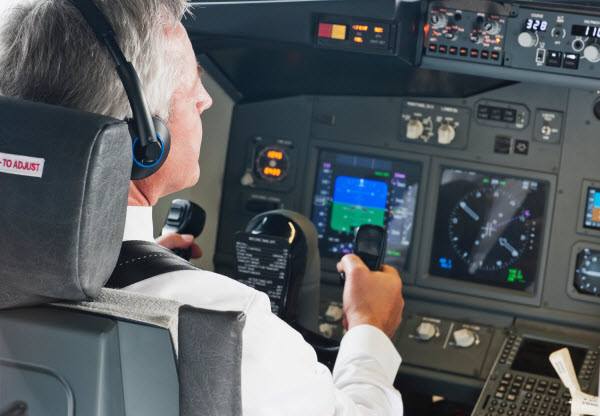
Photo courtesy of FAA
Predicting the future is a unique challenge, often fraught with uncertainty and ultimately failure. The concepts behind strategic planning as both a practical and theoretical exercise attempt to define a point in time into the future from which strategies and tactics can be derived. At the Integrated Communications Navigation and Surveillance (ICNS) Conference, we applied a modified version of scenario planning to elicit from workshop participants what the future of CNS might hold.
To create a unique and interactive experience, the approximately 100 participants in the conference participated in an exercise wherein each was asked to consider the risks (to be mitigated) and opportunities (to be exploited) related to communications, navigation, and surveillance that may arise in a theoretical, fictitious version of a future world. In total, four of these worlds were presented to the participants, and the essential characteristics of each appear here:
| World |
Global Affairs | United States | Tech & Research | Aerospace Sector | Other |
| A | Tide is High (Holdin’ On) | Pervasive global tensions | US economy up but military down | Major tech advances | Healthy travel demand | Significant UAS use |
| B | Blurred Lines | Rise of non-state actors | Failing US government | Private-led R&D | Strong but stratified travel demand | ATC ops & infrastructure vary across US |
| C | Games Without Frontiers | Climate disasters & dislocation | Wealth & access disparities | Game-changing tech innovation, led by US | Dynamic & diverse airspace | Extensive public-private partnership |
| D | Contagion | Global paralysis due to pandemics | Tight economy & government austerity | Little tech innovation | Stagnant aerospace industry | All attention on health security |
Identified risks and opportunities were discussed among small groups assigned to each world. After 15 minutes or so, each participant was asked to then transition to participate in a new ‘world’ wherein they could interact dynamically with the ideas generated by the other group(s). To do this, they:
- Placed a sticky dot by items with which they strongly agreed
- Shared comments or questions on particular risks or opportunities using a post-it note
- Wrote additional risks or opportunities for this world on the appropriate flip charts.
Some of the key thematic takeaways from this fascinating exercise focused on the role of cybersecurity, increasing integration of the National Airspace System (NAS) with the internet, artificial intelligence, and the future of international aviation harmonization. Below we have summarized some of those insights, which raise intriguing questions to help guide how we think about the possibilities of what “could be” over the next 20 years.
- The authenticated and reliable security of the command and control (C2) links for unmanned systems will be paramount to the long-term viability of leveraging these technologies for longer operations, at higher altitudes, and with increasingly heavy payloads.
- Space-based CNS technologies are likely to face increasing and more complex vulnerability risks both in terms of physical and cyber warfare as commercial space operations become more frequent.
- Artificial intelligence poses a unique challenge when it comes to certifying the safety of a ‘smart’ system, both in mitigating the risk of malicious actors on that process as well as in developing controls to ensure the intelligence designed into these systems appropriately prioritizes safety.
- The United States lags behind other nations in developing a sustaining a workforce capable of addressing the cybersecurity needs we face in Defense and Aerospace today, and that gap in our workforce risks growing over time as demand for those skill sets increases globally.
- Different versions of the future may have economic and/or technology drivers that accelerate the ‘corporatization’ of CNS technologies, and in these scenarios, such an approach can increase the risk of penetration or breach of controls intended to maintain the integrity of capabilities that, today, are operated by many nation-states.
- Evolving the approaches taken to plan, implement, and sustain safety management systems and safety cultures within Aviation will be critical as airspace hazards evolve with new entrants and ‘denser’ airspace.
- It is unclear how the international aviation community can best work together to mitigate the security risks associated with an increasingly interconnected set of systems over time, as technologies and innovations within both aviation and the broader Aerospace market continue to accelerate. For instance, the broad presence of an increasing set of internet vulnerabilities will, at a minimum, impact the strategy for effectively operating CNS capabilities in an increasingly networked environment.
- The potential for more, smaller, localized airfields to facilitate more point-to-point travel raises both issues and opportunities in the areas of land use rights and the government’s role at the federal, state, and local levels to enable this potential trend.
- As new entrants with increasing network connectivity enter the airspace, the capacity of the spectrum available to support this network will be strained and may ultimately be overcome if advancements cannot be made around different forms of communication.

A snapshot of the nearly 300 ideas generated by this exercise.
In total, the participants generated nearly 300 individual ideas exploring the possibilities of what could-be across these four futures. No matter what the actual future may hold, we can see how very much there is to do as an aviation community to enable our shared success!
Bob Etris is the aviation director for Evans Inc.